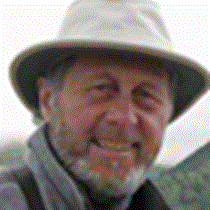Frederick Sound, Alaska
Linear clouds, thin and silent, hung over the deep green forest of a hidden bay. It was early in the morning. Our ship moved slowly in a wide arc, first toward a narrow fjord and then toward the morainal ridge and “estuary” of the massive Baird Glacier. Unlike the glacier we experienced yesterday, this river of ice, which courses from the towering Stikine Ice Field, has retreated over the past few decades. It no longer reaches tidewater. Its days of calving huge blocks of ancient ice into the ocean have ended...at least for now. The snout of this icy conveyor melts slowly. It dwindles into a melt-water stream.
Carried on the conveyor have been countless tons of rock, gravel, sand and silt. They have formed a wide terminal moraine and alluvial fan – the estuary. Animals gather here, most awaiting the annual return of Pacific salmon. Within the next few weeks these ocean wanderers will migrate back to their birth stream, carrying in their bodies a bounty of nutrients gathered over the past 2 to 4 years. They will leave those nutrients here, in the form of eggs to perpetuate the species, or as edible protein and fat to feed the eagles, bears, wolves, mergansers, harbor seals and many other species. Each salmon will die after spawning. The melt-water stream and estuary will be rich.
Already here were about 60 seals, all bunched together on an open gravel bar. They were bear-proof and wolf-proof. By positioning themselves well in the open, they could easily lunge back into the milky water if a predator approached.
We escaped rainfall today, but great volumes of water still poured out of the coastal mountains. A walk up a rushing stream led to a roaring waterfall and a scene that we won’t forget. Some hiked above the falls and into deep mud, while others were content to simply reach the cascade and its endless spray.
Petersburg is a wealthy town. The salmon, herring, halibut and crab fishery of southeast Alaska have made many millionaires. Their well-appointed boats were waiting for us at dockside as we built our own ice cream sundaes after lunch. Some of us took off into the air to study the glaciers from above and to admire equally thrilling geological features. Others ventured through a thick forest and out into an open bog habitat. Still others wandered into town...perhaps looking for the millionaires.
It was another delightful day in the 50th state.
Linear clouds, thin and silent, hung over the deep green forest of a hidden bay. It was early in the morning. Our ship moved slowly in a wide arc, first toward a narrow fjord and then toward the morainal ridge and “estuary” of the massive Baird Glacier. Unlike the glacier we experienced yesterday, this river of ice, which courses from the towering Stikine Ice Field, has retreated over the past few decades. It no longer reaches tidewater. Its days of calving huge blocks of ancient ice into the ocean have ended...at least for now. The snout of this icy conveyor melts slowly. It dwindles into a melt-water stream.
Carried on the conveyor have been countless tons of rock, gravel, sand and silt. They have formed a wide terminal moraine and alluvial fan – the estuary. Animals gather here, most awaiting the annual return of Pacific salmon. Within the next few weeks these ocean wanderers will migrate back to their birth stream, carrying in their bodies a bounty of nutrients gathered over the past 2 to 4 years. They will leave those nutrients here, in the form of eggs to perpetuate the species, or as edible protein and fat to feed the eagles, bears, wolves, mergansers, harbor seals and many other species. Each salmon will die after spawning. The melt-water stream and estuary will be rich.
Already here were about 60 seals, all bunched together on an open gravel bar. They were bear-proof and wolf-proof. By positioning themselves well in the open, they could easily lunge back into the milky water if a predator approached.
We escaped rainfall today, but great volumes of water still poured out of the coastal mountains. A walk up a rushing stream led to a roaring waterfall and a scene that we won’t forget. Some hiked above the falls and into deep mud, while others were content to simply reach the cascade and its endless spray.
Petersburg is a wealthy town. The salmon, herring, halibut and crab fishery of southeast Alaska have made many millionaires. Their well-appointed boats were waiting for us at dockside as we built our own ice cream sundaes after lunch. Some of us took off into the air to study the glaciers from above and to admire equally thrilling geological features. Others ventured through a thick forest and out into an open bog habitat. Still others wandered into town...perhaps looking for the millionaires.
It was another delightful day in the 50th state.




